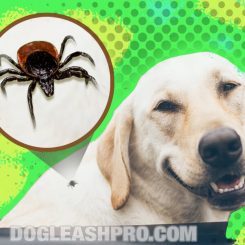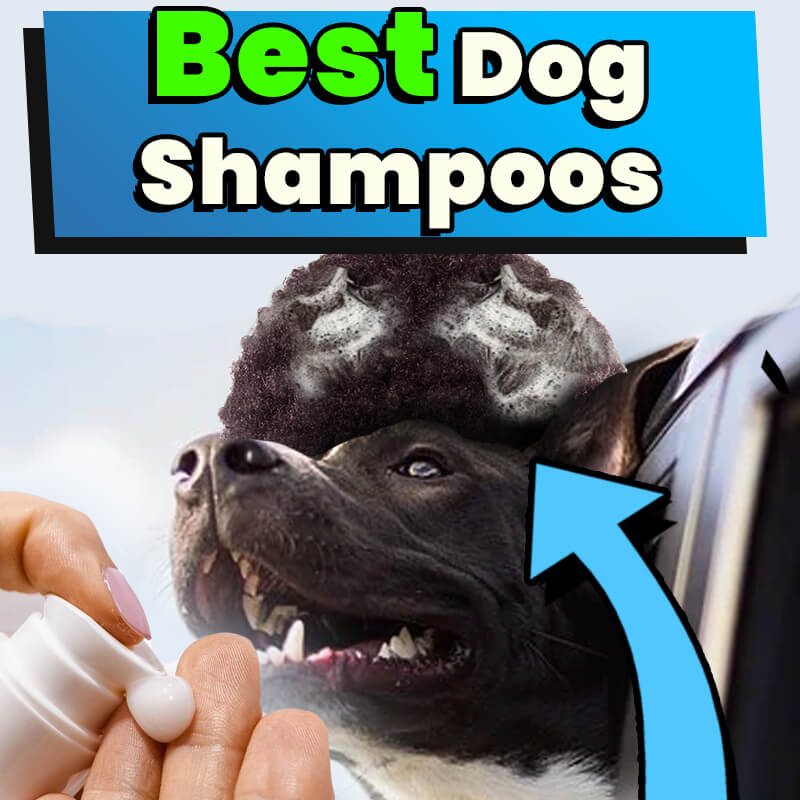

Most dog owners aren’t concerned with their non-hypoallergenic dogs shedding throughout the year since this is normal and it is expected that they shed regularly. But what if you suddenly noticed your dogs losing hair around their eyes, and in large and considerable amounts? Is this normal or should you be worried?
Dog losing hair around eyes: If your dog is losing hair around his eyes, you’ll want to take a closer look at him to see if he is suffering from health conditions such as demodectic mange, fleas and ticks, allergies, infections, Conjunctivitis, or ringworm. Some of these conditions are more severe than others. Regardless, it’s a good idea to consult with your dog’s vet for proper diagnosis, prognosis, and treatment.
In this comprehensive guide, we’ll discuss what causes a dog to lose hair around the eyes and provide the top 9 reasons. We ask that you read through these reasons carefully as some conditions are more serious than others and may require immediate medical attention.
After reading this, you’ll want to confirm your findings with a veterinary professional. Your dog’s veterinarian will be able to perform a thorough health check-up of your K9 friends to find out if there are any underlying issues that may be causing him or her to lose hair around the eyes.
Related Article: Can You Use Baby Wipes On Dogs?
Table of Contents
Dog Losing Hair Around Eyes

A month ago, my friend called me in the middle of the night and sounded worried. She said, “My dog is losing hair around his eyes!” She was almost in sheer panic. Fortunately, I’ve had this same issue with one of my two dogs just a year ago.
I informed her that it could be due to a number of conditions, some minor while others need more attention. Minor conditions that could lead to the dog losing fur around eyes or dog balding around eyes could be due to having ticks and fleas, allergies, infection, or a health issue with the dog’s eye itself.
We highly recommend that you bring your furry friend to a veterinarian as soon you can if you’re not able to identify what the issue is or if you suspect that it can be due to some serious health condition.
Below are the top 9 reasons why there may be hair thinning around dogs’ eyes and what you can do to help.
Why is my dog losing hair around his eyes?
1. Demodicosis
Demodicosis is when dogs have demodectic mange. This is when your pooch contract parasitic skin disease that is usually caused by one of two microscopic mange mites.
Yes, there are two different kinds of mange mites:
- Demodectic mange. The microscopic mites live in your dog’s hair follicles.
- Sarcoptic mange. The microscopic mites live just beneath the surface of your dog’s skin.
Either one of these two kinds of mange mites can cause our dogs to lose hair around their eyes. These mange mites are so small that you won’t be able to see them with your naked eyes. Using a microscope, these mites have eight creepy legs and are shaped like a cigar.
Demodectic mange goes by several other names including red mange and demodex and it is the most common form of mange found in our furry companions.
We’d like to share this one fact that may send chills up your spine and that is all healthy dogs have some mange mites on their hair and skin. If your dog is healthy with a strong immune system, then these mange mites should not cause any harm to him or her.
It’s only when your furry family members have a weak immune system that they have a higher chance of having this parasitic skin disease.
For instance, older dogs or senior dogs may often have a higher chance of getting demodectic mange because their immune system functions usually decline as they age. Thus, if your pooch has a weak immune system due to certain medications they’re taking or other illnesses, then they are more susceptible to demodectic mange.
But can young puppies get demodectic mange? The short answer is yes. If you notice hair loss in puppies around the eyes area, then it could be due to them having this parasitic skin disease.
It is possible for demodectic mange to occur in young puppies since they have an immature immune system. When the puppies’ immune system isn’t as strong, it allows these nasty skin mites to increase in numbers very quickly. This is why you’ll often find this parasitic skin disease occurring in puppies that are less than 12 to 18 months old.
Fortunately, demodectic mange is not contagious to humans and other pets or animals. However, it is important to note that demodex mites can get transmitted from the mother to her puppy during the first few days of his life.
As we can see, puppies and dogs can have demodectic mange and if the microscopic mange mites are allowed to increase by the numbers due to weak or immature immune system, then it can cause skin infections, sores, and even hair loss. This can occur anywhere on the dogs’ bodies, including the skin and hair around their eyes.
Here’s what you can do:
In 90% of the cases, demodectic mange will go away on its own, provided that your dog is healthy and has a strong immune system. However, if your canine companion has a serious case of demodectic mange, then we highly recommend that you bring him or her to see a vet. Your dog’s vet may prescribe flea and tick medications as well as other appropriate medications.
2. Fleas and ticks
Unlike demodectic mange, fleas and ticks are those nasty tiny parasites that like to feed on your dog. They dig their sharp teeth deep into your dog’s skin and feed on your dog for as long as 24 hours.
Their sharp bites and saliva can cause allergic reactions and irritation in dogs. These annoying skin irritation and allergic reactions may cause the dog to lose hair around his eyes.
While you can find ticks and fleas almost anywhere on your canine friend’s body, they are typically located on your dog’s face, specifically around the eyes, muzzle, the base of the ears, neck, and even at the tail.
If you notice your K9 buddy excessively scratching the skin around their eyes, then you’ll want to take a closer look to see if there are fleas and ticks there.
Sometimes you’ll find flea droppings, which look like tiny pepper-like pieces which confirm that there were fleas or ticks present.
You may be interested in: Engorged Tick Fell Off Dog: Here’s What To Do!
Hair loss around dogs’ eyes: Home remedy for fleas and ticks
Luckily, there are several home remedies for fleas and ticks if the infestation is not too severe. You can solve the flea issues by using the following:
- Flea shampoos.
- Chewables that destroys fleas and ticks.
- Spot treatments that removes flea eggs and larvae, fleas, chewing lice, and ticks.
Handy Hint: We’ve listed one of the best flea and tick shampoos you’ll want to get for your dogs if they’re infested with these nasty parasites in our Best Dog Shampoos (Reviews & Top Picks) guide.
However, if the flea and tick infestation is quite severe, you’ll want to take your pooch to see the vet or call your vet as soon as you can. That’s because your dog’s veterinarian is able to prescribe a stronger treatment option you may not be aware of.
While your dog is being treated for fleas and ticks, you’ll want to do the best you can at cleaning any blanket or doggy bed your dog was lying on. These places could still have fleas eggs and fleas present.
Sometimes fleas and flea eggs may surround your dog’s bed so you’ll want to remove the doggy bed and vacuum the carpet or floor underneath the bed as well as the areas around the bed with a powerful vacuum cleaner or a vacuum cleaner that is designed for dogs.
3. Infections
Not only can fleas and ticks cause itchy and irritated skin in dogs, but also they can cause infections, such as fungal infections and bacterial infections. In fact, Ehrlichiosis and Anaplasmosis are two tick-borne bacterial diseases that dogs can get from being bitten by infected ticks.
Ehrlichiosis can cause skin rashes in dogs. You’ll most likely find ticks on your dog’s face, specifically near his eyes, nose, ears, and head.
If the infected ticks or fleas feed on areas around your dog’s eyes, then he or she may experience itchiness, skin irritation, and inflammation around that area. As a result, your furry friends will naturally scratch the skin around their eyes or rub their eyes consistently.
Question of the day: Can Bactine help with skin itching, irritation, and pain? Check out Can You Use Bactine On Dogs? to find out!
Doing this continuously can cause your dog to lose hair around his eyes. While spot-checking your dogs for fleas and ticks, it’s a good idea to look for any red dots or splotches as these are tell-tale signs your four-legged friends may have fleas or ticks on them.
Sometimes our furry friends can also get superficial skin infections around their eyes. This is when the top surface of their skin becomes infected. One such infection that can affect the skin and hair follicles in dogs is Vesiculopustular Dermatoses or skin blisters in dogs.
Symptoms of Vesiculopustular Dermatoses in dogs include:
- Loss of hair and skin pigment.
- Red, irritated, and itchy skin.
- Blisters or vesicles in which the outer layer of the dog’s skin (epidermis) is filled with clear fluid.
- Pustules in which the outer layer of the dog’s skin is filled with yellow or white pus.
Here’s what you can do:
If you suspect your pooch has a skin infection, contact your veterinarian right away. Your dog’s vet may ask you to bring him or her in for a physical check-up.
At the vet’s office, your dog’s vet will check the severity of the skin infection and find out the underlying health issue that’s causing this infection.
While most skin infections will heal or clear up nicely on their own, your vet may have you take the extra step of cleaning the infected skin with antibiotics or prescribe doggy shampoo that can tackle the infections caused by fleas and ticks.
4. Allergies
Sometimes irritated, itchy, and inflamed skin in dogs can be caused by allergies. Some dogs are allergic to dust, pollen, or even certain types of food so when your pooch is in contact with these allergens, their eyes may start to become red and watery and they may also have a runny nose or sneeze a lot more than usual.
Your canine companions will then rub their eyes and face on the carpet or use their paws to rub their eyes. If they keep rubbing their eyes (whether with their paws or on the carpet), it can cause them to lose hair around their eyes.
Here’s what you can do:
If you suspect your furry companion has allergies, contact your vet right away. Your vet may ask you to bring your dog in for a physical check-up. The vet will then be able to diagnose and confirm the specific allergen that is triggering your dog’s allergic reaction.
Bringing your dog to the vet is crucial because the sooner you know what is causing your pup’s allergic reaction, the sooner your pup can be treated and avoid any further hair from falling out around his eyes.
Sometimes skin disease due to food allergies can cause your dog to lose hair around his eyes. Your veterinarian can help you figure out which type of food he is allergic to so you do not give him any more of that food.
If the allergy is due to environmental factors such as pollen, mold spores, dust, dander, harmful germs, or other allergens, then the vet may recommend getting a HEPA air filter with UV-C lights that not only traps dust and other harmful particles but also can destroy airborne viruses such as staph, influenza, influenza, or other types of airborne viruses.
As a dog owner myself, I highly recommend the GermGuardian True HEPA Filter Air Purifier for Home and Pets. Within a day of using this air purifier, I noticed a major difference in the air quality inside my home, and my dogs are no longer scratching their skin and losing the hair around their eyes. The air purifier comes with a 5-year warranty which is a bonus.
DISCLAIMER: THIS WEBSITE DOES NOT PROVIDE MEDICAL ADVICE
The information, including but not limited to, text, graphics, images and other material contained on this website are for informational purposes only. No material on this site is intended to be a substitute for professional veterinary advice, diagnosis, or treatment. Always seek the advice of your veterinarian or other qualified health care provider with any questions you may have regarding a medical condition.
Resources:
https://bmcvetres.biomedcentral.com/articles/10.1186/s12917-015-0515-5

With over five years of specialized experience as an animal writer, my expertise lies in dog nutrition, health, behavior, grooming, and training. I am dedicated to delivering helpful and informative content that caters to the well-being of our furry friends. My primary goal is to empower pet owners with knowledge and ensure our canine companions thrive in health and happiness. In my free time, I love volunteering at local dog rescue centers.











